Georg Luger is known today for just one firearm: the Luger pistol. However, he actually spent significantly more time during his career working on rifles than he did on that iconic handgun. One project in particular that he tackled for the DWM concern was a series of improvements to the Gewehr 88 rifle.
The G88 had been designed rather haphazardly by committee, and was not a particularly successful rifle. This, of course, presented opportunities for improvement, and Luger showcased both his fundamental strength and weakness in his work to improve the design. He was quite talented at refining and existing design, and he was able to improve many details of the G88 ( being granted no fewer than 17 German patents for different improvements between 1893 and 1896). However, he was not so gifted in fundamental design creativity, and in this case his improvements were all for naught, as Mauser’s model 98 rifle did not have the weak elements of the G88 in the first place.
Most of Luger’s improvements involved safety, preventing rounds from firing out of battery and improving how the action handled vented gas in the case of a ruptured cartridge. However, he did also improve the magazine such that it would be loaded with either a 5-round Mannlicher-style clip or with loose rounds – and that a partially-expended clip could be “topped off” in the action with loose rounds. Also clearly visible below is a rotating magazine cover to prevent dirt from entering the mechanism through the clip ejection port.
During the 1890s, DWM manufactured several hundred of Luger’s improved Gewehr 88 rifles. A few were actually tested by the US Navy, where they lost out to James Paris Lee’s model 1895 straight pull, and they were also competitive in German trials, where they lost out to the Mauser 98.
Courtesy of of the James D Julia auction house, I have a selection of photos of a barreled action from an 1896-manufacture Luger rifle – note that Luger has added his personal “GL” monogram to each part covered by one of his patents. This particular rifle is not proofed, and was probably a presentation model (also note the stutzen-stlye double set triggers).




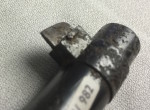
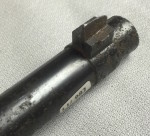

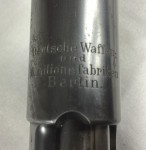
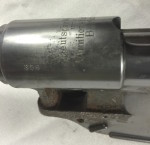





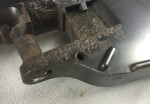

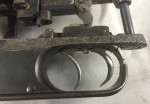
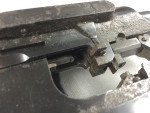
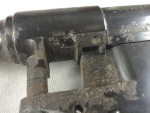


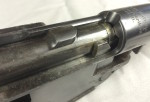
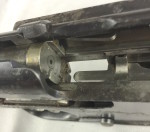


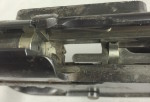
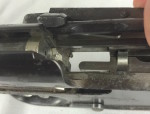


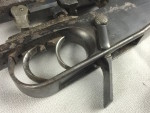

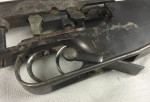








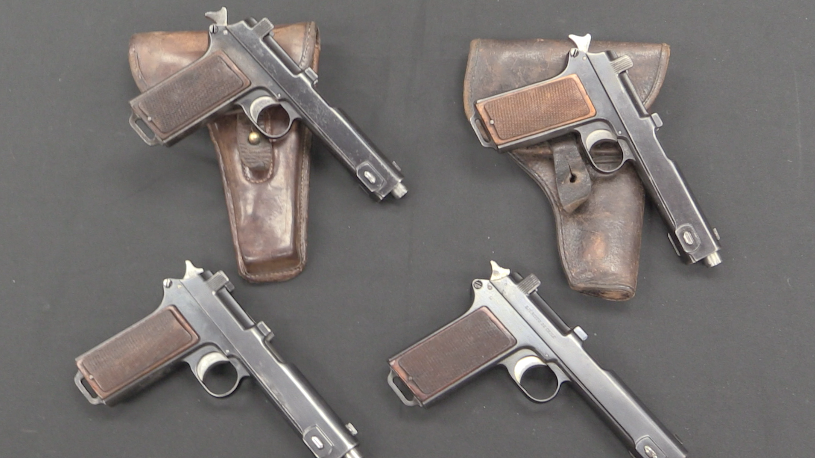
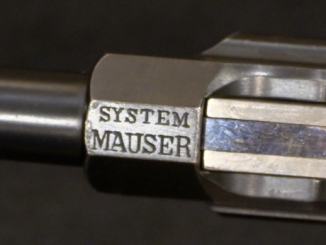
The double triggers, and bolt handle are somewhat reminiscent of the Mannlicher schoenauer. There doesn’t appear to be a bolt mounted saftey lever as on the 88 or the Mannlicher, perhaps the double trigger incorporates a safety as oppose one being a set trigger presumably on the Schoener. The 88 did have problems with ruptured cases and thus the requirement to vent gas apparently, I assume that had something to do with firing out of battery. I think I read something about double feeding which may have been connected to that, and thus ruptured cases. Having a magazine you could also load individual rounds in, is an improvement to the en bloc clip I think. It would be the front trigger the safety, I imagine. Not sure how it would work, perhaps when you pull it lifts the triggers “thing” to connect with the bolts “thing” sear, disconnecter and whatnot. Lots of history in these old pieces, interesting era etc.
Gewehr 88 was first German mass-produced smokeless powder rifle, it was rushed into production hence some flaws. Due to fact that one of manufacturer was Ludwig Loewe Company owned by Jew it was dubbed Judenflinte by German press.
BTW: On wikipedia i found this picture:
https://commons.wikimedia.org/wiki/File:Gewehr_88_patronen.jpg
Why these cased are so deformed? Description say only:
“2 cartridges for Gewehr 88. Found: Namibia (earlier German South-West Africa), Neuhof-Kowas farm, used by Schutztruppe”
Why are they so deformed? Because they have been stepped on at some point in the last 100+ years.
“rather haphazardly by committee, and was not a particularly successful rifle”
German first tank – A7V was also designed by committee and proved to be inferior to British tank. IIRC many members of committee has different point-of-view to what is or is not needed.
Rule by committee was the way the A7V was crewed, as well. The main gun crews were from the field artillery, drivers and mechanics from transportation, etc. Most of the vehicle commanders were cavalry, and considered being stuck in an iron box with a bunch of “other ranks” an insult to their dignity.
Very little actual crew training was done, and internal enmity was the rule rather than the exception. As was related in one book by Col. John Weeks, “when a German tank crew machine gunner said he was ‘let down by the artillery’, he was referring to the 57mm gun crew of his own tank.”
Hardly a “band of brothers”.
cheers
eon
I beg to disagree, Daweo: just being a committee’s design doesn’t nullify the ability to shine of any committee-designed weapon. It’s the level of the committee members, that defines the quality of committee-designed guns – and that was the plight of the G88 – simply Armand Mieg lacked the facilities to design a succesfull rifle – plus being in a hurry to stem the French tidal wave with Lebels, plus being in a Prussian military, hell bent on keeping Mausers where they belonged, in provincial Baden-Wurttemberg. All of these, plus von Mannlicher’s ability to sell on his Packett-Ladung racket, conspired to strangle the resulting Gew 88.
But it was not the case each time, all of the times. Just keeping to the German stuff, both MP 38 and MG 34, not especially known to be overly defective ones, were also, mind you, created by a wretched committee (HWA’s Wa Pruf 2), and even worse, they were in fact Frankenstein’s Monsters, cobbled together of the elements of several different designs, essentially merged into a single project. Also, the Mosin rifle was a committee design, even though centered around the Mosin action with Nagant’s magazine and stripper-clip. One might say many things about the resulting rifle, but “utmost failure” would be simply unfair. Even though I’m still rather partial to another gang-bang design: the Lee-Enfield rifle.
I agree with Leszek. MG42 and Sturmgewehr 44 were also products of WaPrüf 2.
Living in Bavaria, I cannot help but pointing out that Armand Mieg was a Bavarian officer, not a Prussian. As was Adolf Fischer, the officer responsible in GPK for creating the artillery Luger (lange Pistole 08). Saxony and Bavaria kept their own armies until 1918.
G36 and MG5 show that leaving conceptual thinking to industry alone may not be a good idea.
I don’t say: “each weapon designed by committee is fail”, I only point that A7V was other weapon designed by committee which proved be to not very good.
The safety on the Luger is the lever mounted on the side of the mag.
I am surprised that the Luger did not win the US Navy trials. IMHO the Gew 88 was far superior to the 6mm Lee Navy Rifle.
All of the other contestants in the trials were rifle design also rans. Proven arms like the Berthier, Lee Metford , M1893 Mauser and others were not submitted.
Isn’t that the magazine cover, rotator. The lever on the side of the mag, the lever that extends rearwards past the trigger guard when said flapper is closed…
With the rust neutralised and the barrelled action inlet into a period style stock…
That is a fantastic historical rifle, if the bore is OK ( I gather the .318″ bores will shoot surprisingly well despite pitting) it will stand next to Mannlicher’s version of the 88, on any game shoot.
Regarding committees: a giraffe= a horse designed by committee.
British tanks were also to be subject to job demarcation lines, though arguably hmmm, more or less so than German tanks. As steel vessels, they were originally to fall under
Naval auspices… Rum, sodomy and mutiny.
“As steel vessels, they were originally to fall under
Naval auspices”
Then they were called “landships” and sometimes HMLS was used (His Majesty’s Landship) for example HMLS Diehard: http://warart.archives.govt.nz/node/449
As a new weapon tanks have to be placed somewhere in existed branches, IIRC early French tanks were considered to be artillery.
“Rum, Buggery and the Lash ” is the original quotation referring to the Royal Navy; also the Camel was designed by the Horse Committee…quite a SUCCESS IN ITS OWN DOMAIN (THE DESERT).
obviously from the Rust, the Markings, and the Barrel sling point, this was a Sporter made by DWM (after 1897) maybe as a gift, or presentation Piece, or special order Hunting Rifle.
It would be nice to see some History on it (who for, who owned, what happened to it to get so damaged, etc.
BTW, the BORE is .311 (7,9mm) the Rifling, Grooves at this stage, will be .3195-321″(J) ( as in “z” marked Gew88s…deepened grooves.) The BULLET is around the .317-.318″ diameter.
Doc AV
Argh… I wonder what a fully stocked army version would look like. Would it be just another G.88?
The Navy trials rifle illustrated in “The Winchester Lee Rifle” looks like a G88 without barrel jacket and fitted with a wood hand guard.
The Gew-88 is one of the more accurate shooting rifles that I own…maybe it is just the example I own..perhaps it is the barrel jacket. Mine slugs at .322 and had the “S” modifications. Despite it’s quirkiness, I would not feel under gunned with it.
This is known in the trade as a free-floating barrel, where the barrel does not have any real contact with the rifle stock. The barrel is free to vibrate at its natural frequency in this configuration, with no interference from the rest of the weapon. Sadly, the shroud of the Gewehr 88 also attracted moisture and rust, just as the experimental side-plate for the prototype Type 94 pistol attracted moisture and induced rust. So the Gewehr 88 is accurate as intended, but maintenance heavy. Even so, it can be made into a good sporting rifle with some tweaking here and there.
Am I wrong on this?
The Gew88 action was derided by American gun writers for decades but when it was fitted with a Schoenaeur mag and a high price tag it became the best. Go figure.
Reading the synopsis of the USN trials it appears the Luger did very well but was rejected for a few minor faults the major one being that its muzzle velocity was less. I suspect it may also have faced prejudice since it was foreign designed. In 1890 the US Army adopted the Krag but faced opposition in Congress since it was foreign. The US Army had to have another series of trials in 1892 and again adopted the Krag.
Sounds like the FAL vs M14 controversy in the 50s.
I never found my Gew/Kar 88 very maintenance intensive…but then again I started out with a M-16A2 and M-4. If I remember correctly, the Germans just greased the barrels. I also find cleaning guns relaxing. Emperor William II had quite a nice sporter version of the Gew-88. Perhaps this Luger commercial action looked like this?
http://www.nramuseum.org/guns/the-galleries/wwii,-korea,-vietnam-and-beyond-1940-to-present/case-43-presidential-and-royal-guns/spandau-m1888-sporter-rifle-attributed-to-kaiser-wilhelm.aspx
Nice find!